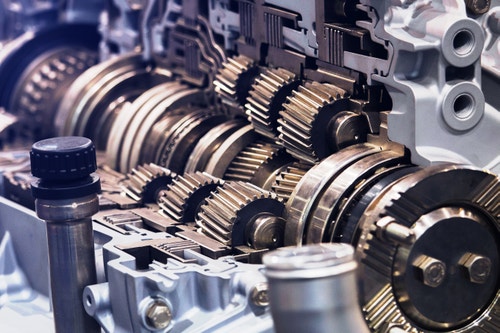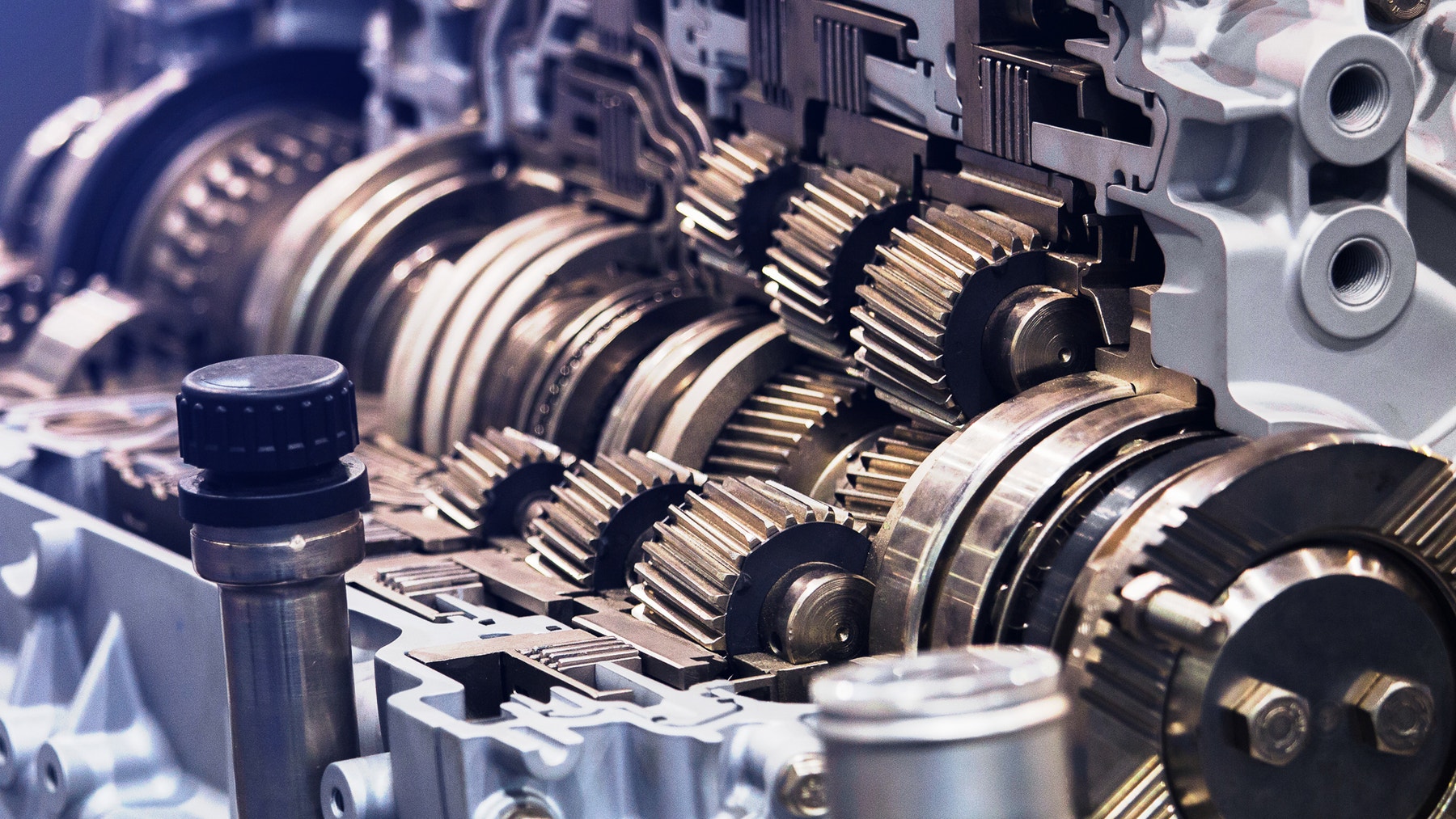Shifting Gears
Build a Geared Vehicle to investigate the impact of using different gear trains.

Lesson plan
1. Prepare
- Read through the student material in the EV3 Classroom App.
- Collect some information about gear transmissions that will help your students understand concepts such as gearing up and gearing down.
2. Engage (5 Min.)
- Use the ideas in the Ignite a Discussion section below to engage your students in a discussion related to this lesson.
- Split your class into pairs.
3. Explore (20 Min.)
- Have each pair of students build the Geared Vehicle.
- Give them some time to do a test run to ensure that the model is built correctly and works as expected.
4. Explain (10 Min.)
- Have each team perform the experiment at least three times for each of the suggested gear trains, and record their results.
- Make sure they can create their own testing tables.
5. Elaborate (10 Min.)
- Have your students analyze how gear ratio relates to the distance traveled and velocity of the vehicle.
- Ask each team to briefly summarize the results of their experiments.
- Don’t forget to leave some time for cleanup.
6. Evaluate
- Give feedback on each student’s performance.
- You can use the assessment rubrics provided to simplify the process.
Ignite a Discussion
It’s difficult to travel uphill or against the wind on a bike. A good gear system is useful in adjusting the power needed to keep moving. When traveling across level ground, you start off in a low gear and then shift into higher gears at higher speeds.

Start a discussion about shifting gears by asking relevant questions, like:
- What do the terms transmission and gear reduction refer to?
- Why are gear units often encased?
- What’s the relationship between the gear ratio and the distance traveled?
- In which situations is gear reduction desirable? In which situations is it not?
Building Tips
Building Instructions
Using the Model
Place the vehicle at least 10 cm from a wall with the Ultrasonic Sensor positioned perpendicular to the wall. Run the program and wait until the EV3 icon is shown on the Display. Press the Center Button on the EV3 Brick to start the test run. The initial distance to the wall is measured using the Ultrasonic Sensor, and the timer is reset. The vehicle will move away from the wall by running the Large Motor for one rotation. The distance to the wall is measured again, and the elapsed time is measured to calculate the distance traveled, velocity, and rotational speed. The calculated values are shown on the Display until the Center Button is pressed again to prepare for another test run.
Using the Ultrasonic Sensor
The Ultrasonic Sensor generates sound pulses, which form a sound cone in which objects can be detected. When starting the experiment, don’t stand next to the vehicle or within the Ultrasonic Sensor’s sensing cone; the best place is behind the Ultrasonic Sensor.
Running the Experiment
As they’re running their experiments, remind your students of the following:
- The distance traveled (in cm), velocity (in m/s), and rotational speed (in revolutions per second) will be shown on the Display.
- Record the experiment number, gear ratio, your prediction of what’ll happen, distance traveled, and velocity in a testing table. Make sure to leave enough space to record other observations.
- Perform the experiment at least three times for each gear train option and use the average values to ensure the most reliable results.
- Refer to the images in the “Hint” to see how to change the gear trains.
Coding Tips
Program

Differentiation
Simplify this lesson by:
- Working with your students to help them analyze how gear ratio relates to the distance traveled and the vehicle’s velocity
- Reducing the number of gear trains the students must investigate
Take this lesson to the next level by:
- Explaining the significance of average values (e.g., arithmetic mean versus the median, susceptibility to outliers) that can be used to equalize the measurement errors across a series of experiments
- Encouraging the students to define a function to predict the distance traveled based on the gear ratio
- Challenging your students to come up with ways of improving the accuracy of their experiments
Assessment Opportunities
Teacher Observation Checklist
Create a scale that matches your needs, for example:
- Partially accomplished
- Fully accomplished
- Overachieved
Use the following success criteria to evaluate your students’ progress:
- Students described the role of gear ratio in predicting the outcome of their experiments.
- Students applied mathematical concepts and/or processes to determine the relation between gear ratios and the distance traveled.
- Students evaluated the experiments’ procedures and identified independent, dependent, and control variables.
Self-Assessment
Have each student choose the level that they feel best represents their performance.
- Bronze: I’ve performed the experiments but didn’t describe the role of gear ratio in predicting the outcomes of the experiment.
- Silver: With some help, I’ve described the role of gear ratio in predicting the outcomes of the experiment.
- Gold: I’ve used my understanding of the role of gear ratio in the experiments to predict which gear ratio should be used in a vehicle suitable for moving heavy loads.
- Platinum: I’ve used my understanding of the role of gear ratio in the experiments to predict which gear ratio should be used in a vehicle suitable for moving heavy loads. I’ve also predicted which gear ratio should be used in making a fast vehicle.

Language Arts Extension
To integrate language arts skills development, have your students:
- Create a brief report focusing on the results of their experiments and real-world examples of when gearing up and gearing down is useful
- Create a presentation explaining the results of their experiments and what they’ve learned
Note: This will make for a longer lesson.
Career Links
Students who enjoyed this lesson might be interested in exploring these career pathways:
- Manufacturing and Engineering (Pre-Engineering)
- Science, Technology, Engineering & Mathematics (Science and Math)
- Transportation (Automotive Technology)
Teacher Support
Students will:
- Learn in which situations to gear up or down
- Learn that changing gear ratios results in different velocities
NGSS
MS-PS2-2
Plan an investigation to provide evidence that the change in an object’s motion depends on the sum of the forces on the object and the mass of the object.
Common Core
CCSS.ELA-LITERACY.RST.6-8.3
Follow precisely a multistep procedure when carrying out experiments, taking measurements, or performing technical tasks.
CCSS.ELA-LITERACY.RST.6-8.4
Determine the meaning of symbols, key terms, and other domain-specific words and phrases as they are used in a specific scientific or technical context relevant to grades 6-8 texts and topics.
CCSS.ELA-LITERACY.WHST.6-8.7
Conduct short research projects to answer a question (including a self-generated question), drawing on several sources and generating additional related, focused questions that allow for multiple avenues of exploration.
CCSS.MATH.CONTENT.8.F.B.4
Construct a function to model a linear relationship between two quantities. Determine the rate of change and initial value of the function from a description of a relationship or from two (x, y) values, including reading these from a table or from a graph. Interpret the rate of change and initial value of a linear function in terms of the situation it models, and in terms of its graph or a table of values.
ISTE
5B
Students collect data or identify relevant data sets, use digital tools to analyze them, and represent data in various ways to facilitate problem-solving and decision-making.




